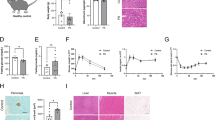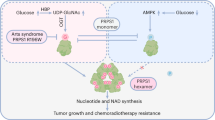Abstract
It has been known that O-linked β-N-acetylglucosamine (O-GlcNAc) modification of proteins plays an important role in transcription, translation, nuclear transport and signal transduction. The increased flux of glucose through the hexosamine biosynthetic pathway (HBP) and increased O-GlcNAc modification of protein have been suggested as one of the causes in the development of insulin resistance. However, it is not clear at the molecular level, how O-GlcNAc protein modification results in substantial impairment of insulin signaling. To clarify the association of O-GlcNAc protein modification and insulin resistance in rat primary adipocytes, we treated the adipocytes with O-(2-acetamido-2deoxy-D-glucopyranosylidene)amino-N-phenylcarbamate (PUGNAc), a potent inhibitor of O-GlcNAcase that catalyzes removal of O-GlcNAc from proteins. Prolonged treatment of PUGNAc (100 µM for 12 h) increased O-GlcNAc modification on proteins in adipocytes. PUGNAc also drastically decreased insulin-stimulated 2-deoxyglucose (2DG) uptake and GLUT4 translocation in adipocytes, indicating that PUGNAc developed impaired glucose utilization and insulin resistance in adipocytes. Interestingly, the O-GlcNAc modification of IRS-1 and Akt2 was increased by PUGNAc, accompanied by a partial reduction of insulin-stimulated phosphorylations of IRS-1 and Akt2. The PUGNAc treatment has no effect on the expression level of GLUT4, whereas O-GlcNAc modification of GLUT4 was increased. These results suggest that the increase of O-GlcNAc modification on insulin signal pathway intermediates, such as IRS-1 and Akt2, reduces the insulin-stimulated phosphorylation of IRS-1 and Akt2, subsequently leading to insulin resistance in rat primary adipocytes.
Similar content being viewed by others
Article PDF
Author information
Authors and Affiliations
Rights and permissions
This is an Open Access article distributed under the terms of the Creative Commons Attribution Non-Commercial License (http://creativecommons.org/licenses/by-nc/3.0/) which permits unrestricted non-commercial use, distribution, and reproduction in any medium, provided the original work is properly cited.
About this article
Cite this article
Park, S., Ryu, J. & Lee, W. O-GlcNAc modification on IRS-1 and Akt2 by PUGNAc inhibits their phosphorylation and induces insulin resistance in rat primary adipocytes. Exp Mol Med 37, 220–229 (2005). https://doi.org/10.1038/emm.2005.30
Published:
Issue date:
DOI: https://doi.org/10.1038/emm.2005.30
Keywords
This article is cited by
-
Prohibitin: a prime candidate for a pleiotropic effector that mediates sex differences in obesity, insulin resistance, and metabolic dysregulation
Biology of Sex Differences (2019)
-
De Novo Lipogenesis as a Source of Second Messengers in Adipocytes
Current Diabetes Reports (2019)
-
Cross regulation between mTOR signaling and O-GlcNAcylation
Journal of Bioenergetics and Biomembranes (2018)
-
O-GlcNAcylation: key regulator of glycolytic pathways
Journal of Bioenergetics and Biomembranes (2018)
-
Placental O-GlcNAc-transferase expression and interactions with the glucocorticoid receptor are sex specific and regulated by maternal corticosterone exposure in mice
Scientific Reports (2017)



